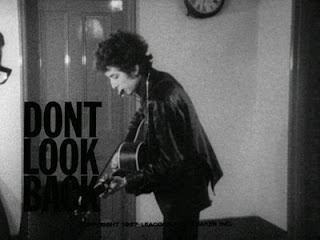Few films have changed documentary film-making more than Don't Look Back. There was absolutely nothing like this movie before.This was not a rock and roll musical like the Elvis films or The Beatles' A Hard Day's Night. Nor was this a straight forward documentary. Nor was this a concert film. This was something completely new and startling. Something nobody excepted but that inspired many generations of filmmakers yet to come. Others have tried to recapture the magic of this movie but no one has ever succeeded. Even today this film feels just as fresh as it must have in 1967.
Director D.A. Pennebaker was a one of a kind filmmaker and in many ways this is his masterpiece. This film had none of the polish that one would see in a Hollywood film. This is often a rather cheaply shot and looks it. However this is what makes the movie so powerful. It makes it feel more intimate and real. Any Hollywood polish would only have the effect of diluting the intimacy and rawness of this this movie. This film is not great in spite of it lacking this Hollywood polish, but rather because of this and this would be one of its largest influences on future documentary filmmakers who would make similarly raw and unpolished films.
This is a very intimate film that shows Bob Dylan in a completely honest light. It never holds back on some of the more off-putting parts of Bob's personalty at the time. When given interviews he is cold and distant to the people asking him questions refusing to give one of them a straight answer. This is a well known facet about Dylan, that he never truly lets anyone into his confidence outside of his music. He never cares to discuss any deeper meanings to his songs, instead wanting the music to speak for itself. Still I do feel sorry for some of the poor reporters who simply are trying to do their jobs. Despite this much of his kidding of these reporters is actually very witty and funny. At times one has a feeling that much of this kidding wasn't meant to be malicious but rather Bob just trying to have a little fun with what had become monotonous to him. Still Bob's basically berating of a Times magazine reporter does take on a surprisingly vicious tone and is more than a little difficult to watch because though I often agree with much of what Bob is saying, I also feel very sorry for the poor man and know that I would truly hate to be in his place. However I am grateful that this documentary does not simply supply us with an idolized or Hollywood-like version of Dylan.
My favorite scenes feature a very different intimacy with Bob and these are the moments he spends either in his hotel room or car with his friends. I especially love the moments they spend sharing songs with one another. I love that he spends time in his hotel room simply playing and sharing songs with his friends. His brief covers of Hank Williams songs are a special delight for me being a fan of both singers' music. I was surprised when I first saw this film at how perfectly Bob's voice fits these classic songs. I also love Donovan and Bob's little song contest (Donovan with To Sing For You and Bob with It's All Over Now Baby Blue). I also love the little joking conversations the group has ("give the anarchist a cigarette") and their reactions to various news stories about them. These moments give you a look at Bob Dylan that can not be seen anywhere but this film, making this incredibly valuable to my fellow Dylan fans.
Joan Beaz almost has a too brief presence in this film. Yet she delights completely with her lovely singing and natural charm in front of the camera.
Don't Look Back is about Bob Dylan's last tour as an acoustic singer (in 1965). However the film opens up with one of Bob's first real rock and roll songs, Subterranean Homesick Blues. This opening sequence predates the music video, but certainly looks ahead to it. This is the famous scene in which Bob holds up cue-cards that contain lyrics as well as some jokes (humor has always been an important part of Dylan). Director D.A. Pennebaker shot this scene multiple times in different locations. Listening to this and comparing it to the performances of The Times They Are A Changin' and The Lonesome Death of Hattie Carroll, it becomes all the more obvious why a song like this truly shocked Dylan fans when it first came out. One has to wonder if him considering this new change in musical styles was why he told a Times reporter that he wasn't a folk singer in this film.
This is a must watch for any Dylan fans and for anyone who wants to watch cinema history as it was being made.
-Michael J. Ruhland

No comments:
Post a Comment